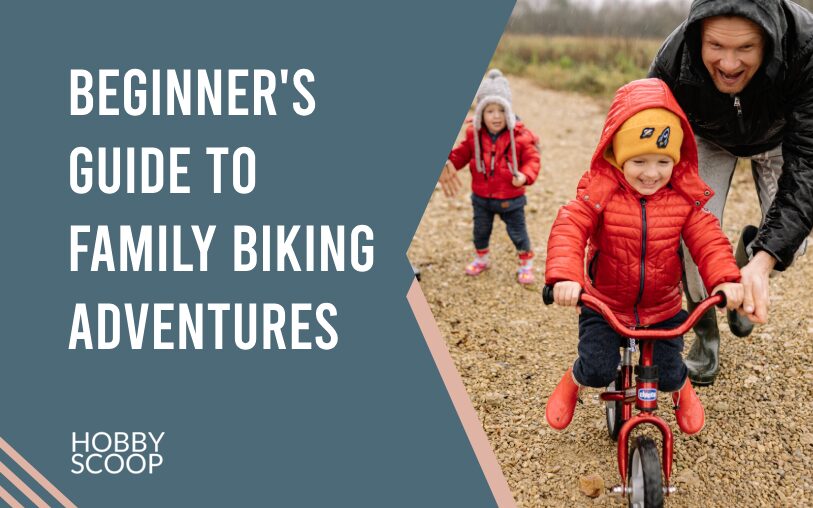Embarking on family biking adventures opens up a world of exploration, bonding, and unforgettable memories. However, diving into this activity, especially as beginners, can seem overwhelming.
This comprehensive guide aims to equip you with practical, actionable advice to ensure your family biking journeys are as enjoyable and safe as possible. From selecting the right gear to navigating your adventures, we’re covering it all.

Selecting the Right Bikes for Every Family Member
Kids’ Bikes: Size Matters
Choosing the right bike for your child is more than a matter of height. It’s about ensuring their first biking experiences are encouraging rather than frustrating. Here’s what to look for:
- Wheel Size: Bikes for kids are categorized by wheel size, ranging from 12 inches for toddlers to 24 inches for older kids. Select a size that allows your child to comfortably reach the ground with their feet, ensuring stability and confidence.
- Weight: The bike should be light enough for your child to handle easily. A heavy bike can be cumbersome for a child to control, leading to a less enjoyable and potentially unsafe riding experience.
- Adjustability: Kids grow fast. Choose a bike with adjustable seat and handlebar heights to accommodate growth spurts.
Adult Bikes: Comfort and Functionality
For adults, the focus shifts to comfort and suitability for the intended adventure:
- Type of Bike: If your adventures include off-road trails, a mountain bike might be your best bet. For city explorations or smooth bike paths, consider a hybrid or a comfortable cruiser.
- Fit: Ensure the bike frame fits your body. You should be able to stand over the frame with a comfortable clearance, and when seated, your leg should have a slight bend when the pedal is at its lowest point.
- Features: Look for bikes with features that enhance your riding experience, such as multiple gears for varying terrains, a comfortable seat, and efficient brakes.
Prioritizing Safety on Every Ride
Helmets: Non-Negotiable for All Ages
A helmet is the most critical piece of safety equipment. It should fit snugly, with the front rim barely above your eyebrows and the strap comfortably tight to keep it from moving. For kids, colorful helmets with their favorite characters can make wearing them more appealing.
Visibility Gear
Especially important for early morning or late afternoon rides, ensure every family member has reflective gear or bright clothing. Equip bikes with lights and reflectors to enhance visibility to drivers and other cyclists.
Road Safety Basics
Teaching your children the rules of the road—like signaling turns, understanding right of way, and using bike lanes correctly—can significantly enhance safety. Practice these skills in a controlled environment before venturing onto busier paths or roads.
Planning Your Biking Adventure
Route Selection: Start Simple
Your first few rides should be about building confidence and stamina. Choose flat, straightforward routes with minimal traffic—a local park or a dedicated bike path are ideal. Use apps or websites to find family-friendly routes in your area.
Packing Essentials
Have a look at many different websites for tips on how to pack for your family. A small backpack or bike bag should include:
- Water bottles for hydration
- Healthy snacks to keep energy levels up
- A basic repair kit with tire levers, a spare tube, and a multi-tool
- Sunscreen and bug spray to protect against the elements
Building Skills and Confidence
Balance and Coordination Drills
Before hitting the road, spend time in a safe, open space practicing basic skills. Set up mini-obstacle courses or use chalk to draw practice trails. These fun activities can significantly improve balance and coordination.
Gradual Distance Increase
Start with short distances, celebrating these early milestones, and gradually increase the length of your rides. This approach helps build endurance in a manageable and enjoyable way.
Making Biking Adventures Fun
Incorporate Exploration and Play
Turn each ride into an adventure by setting goals or destinations, like a new playground, a picnic spot, or a scenic viewpoint. Incorporate games like “I Spy” while riding to keep younger kids engaged and entertained.
Encourage Independence
As skills improve, let the kids take turns leading the group or choosing the route. This autonomy builds confidence and a sense of responsibility.
Staying Motivated: Set Goals and Celebrate Achievements
Challenge Each Other
Set family biking goals, such as completing a specific trail, reaching a certain distance, or mastering a new skill like riding no-handed for a few seconds. Celebrate these achievements with a special treat or recognition.
Join a Community
Connect with other biking families or join local events and group rides. These communities offer support, motivation, and the chance to make new friends with similar interests.
Wrapping Up
Family biking adventures are about more than just physical activity; they’re about creating lasting memories, exploring new places, and growing together. By starting with the right equipment, prioritizing safety, and gradually building your biking skills, your family can enjoy the countless benefits of this wonderful outdoor activity. Remember, every ride is an adventure, and every adventure brings your family closer. Happy biking!
